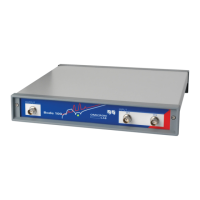75
Calibrating the Bode 100
7 Calibrating the Bode 100
The Bode 100 can compensate effects of the measurement setup like cables
and probes. Further on the overall accuracy may be improved by calibrating the
Bode 100 (e.g. if the operating temperature is outside the range specified in
12.5 "Environmental Requirements" on page 137).
7.1 Calibration Methods
The Bode 100 supports two calibration methods: the Probe Calibration
optimized for measurements which require frequent changes of measurement
settings and the User Calibration for most accurate results.
Note: During startup, the Bode 100 executes an Internal Calibration algorithm.
During this calibration, internal attenuators and amplifiers are measured and
calibrated.
7.1.1 Probe Calibration
The Probe Calibration of the Bode 100 allows you to change several
measurement parameters without the need of recalibration. During the
Probe Calibration, calibration factors are determined at factory defined
frequencies within the complete frequency range. The calibration factors for the
frequency points used by the current measurement settings are then obtained
by interpolation.
Hint: The Probe Calibration compensates effects of cables and broad-band
probes. If you want to compensate frequency selective probes or if your cable
length exceeds 10 m it is recommended to use the User Calibration (see
7.1.2 "User Calibration" on page 76).
The Probe Calibration allows changing the following parameters without the
need of recalibrating the Bode 100:
• Frequency values
• Sweep mode (linear/logarithmic)
• Number of measurement points (in the Frequency Sweep modes)
• Source level
• Attenuator 1 and attenuator 2
• Receiver bandwidth
•Zoom with & without the Copy from Zoom function
(see "Copy from Zoom" on page 107)

